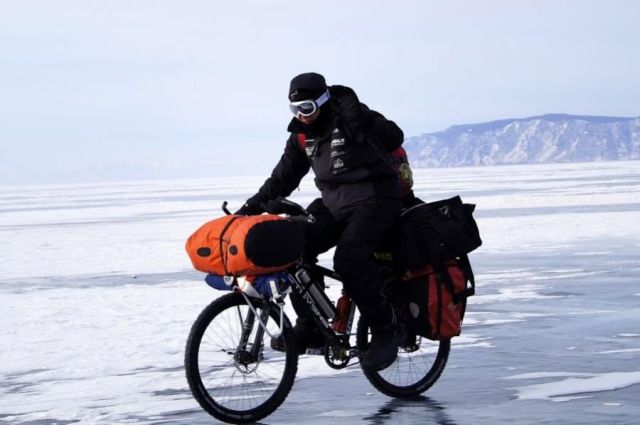Lake Baikal is the most ancient freshwater lake in the world and measures 1,643 m (5387 ft) deep at the deepest spot. In average it measures 48 km (30 mls) across and 673 km (418 mls) in length along its middle line. During February it is usually covered by a layer of ice an average of 1 m (40 in) thick.
Extreme athletes Wolfgang Kulow and Stefan Schlett will use that layer to cross the lake from its northern to its southern tip on their STEVENS bikes. ”All in all it’s going to be well over 1,000 km.” says Kulow. They will circumnavigate certain areas of the shore line, criss-cross the lake a couple of times and spaciously circumnavigate warmer undercurrents under the ice.
”We plan to go roughly 50 km a day,“ Kulow continues, and Schlett adds: ”Yet, an average of 50 km also means that one day we might push our bikes through snow and headwind for 10 km and the other day racing 80 km over unobstructed ice and assisted by tailwind.” Where exactly they will travel depends on the quality of the ice. In any case they will start in Severobaikalsk at the north end. They will head for the so called Shaman Rocks, a pilgrimage site on the island of Olchon about in the middle of the lake. Located only a few kilometers away from the island is the deepest point of the lake. Kulow: ”We are of course looking forward to stand right above it.”
To prevent the travel turning into a glissade the bikes are shod in spiked Schwalbe Ice Spiker Pro tires. ”With these riding on ice works awesome, like normal.”, says Kulow. His 2012 STEVENS Speed Flight, he already used in 2013 to travel Lake Baikal - on this first attempt, where these photos were shot, he was stopped by drift ice – is equipped with a Rohloff Speedhub, suspension fork and a SON hub dynamo. Stefan Schlett will use a 2013 STEVENS Juke hardtail as a base for his travel bike. ”Around the world, 26 inch wheels are the easiest to get replacement parts for”, says Schlett.
Why are these guys doing this? ”We are asked that questions quite frequently”, says Wolfgang Kulow. ”It’s about pushing the envelope, to answer the question what is possible, what are man and material capable to bear.” Mental strength is a decisive factor is what he learned from his first attempt two years ago.
”The lake is a fantastic, refrigerated environment. But it’s also a hostile environment”, says Schlett. In the hottest deserts of the world, which both have also traveled, there’s times when temperatures pleasantly shift from very hot in the day to cold at night. ”This will not happen on Lake Baikal, here temperatures will shift from -15 to -36 degrees Celsius (5° to -33° F).”
”It’s about accepting a situation just as it is”, says Stefan Schlett. In such a situation, while participating in a 10-time Ironman the two had gotten to know each other. After swimming 38 km (24 mls) there was a storm, no one would even think about riding a bicycle when palm trees would bent under the wind in a rectangular manner. ”I was in a really bad mood and loudly complaining about the shitty weather”, says Kulow. ”And then Stefan Schlett is beaming with delight saying he actually liked the weather.” Schlett answers: ”It’s not quite accurate, that I liked the weather but when you try to fight it, it only exhausts you.”
The lake itself is fascinating, says Schlett in earnest. There’s about a thousand endemic animal species, meaning species that only exist in that very area. And in addition to the icy landscape it’s the huge dimensions the lake features: ”With the amount of water the lake contains you can supply all humanity with fresh water for the next 50 years.”
Mostly, Wolfgang Kulow und Stefan Schlett will spend the night in a tent on the ice. Near Khuzir, after about half of their journey they will go ashore to resupply fuel for the stove.
At the time they have already arrived in Severobaikalsk after a two-day trip on the Transsiberian Railroad, facing temperatures of -25° C (-13°F). No matter how well they make progress, they need to have reached their destination Kultuk by March 15th, because that is when their return flight is booked. Wolfgang Kulow und Stefan Schlett have planned to report from their trip on a regular basis. Then there will be lots to read and lots to watch, right here on this webpage.
Wolfgang Kulow
Wolfgang Kulow is an extreme athlete. Since when he was a child in Großenbrode, northern Germany, right next to the Island of Fehmarn, he loved adventure and athletic challenges. The Baltic Sea was the ideal place to explore nature. At seven years old he began Scuba diving. Later, when serving in the German Navy he was all into swimming, running and diving. As time went by he set new extreme sports world records, among them the Trans-Germany Triathlon, 10 K-Underwater Cycling – right at home – 1 K underwater cycling through the Fehmarn Sound.
Source: www.wolfgang-kulow.de and www.extremsport.net
Stefan Schlett
Stefan Schlett is an extreme athlete who is into ultra long distance running, sky diving, triathlon and mountaineering, He is one of only two people in the world to have crossed three continents in competition: In 1992 America, in 2001 Australia and in 2003 Europe. He is also the first German to have run a marathon on every continent, and he holds the German record in several ultra marathons between 1,000 km and 1,300 miles. In the first ever Deca-Triathlon in Monterrey, California he made second place.
Source Wikipedia: https://de.wikipedia.org/wiki/Stefan_Schlett




















